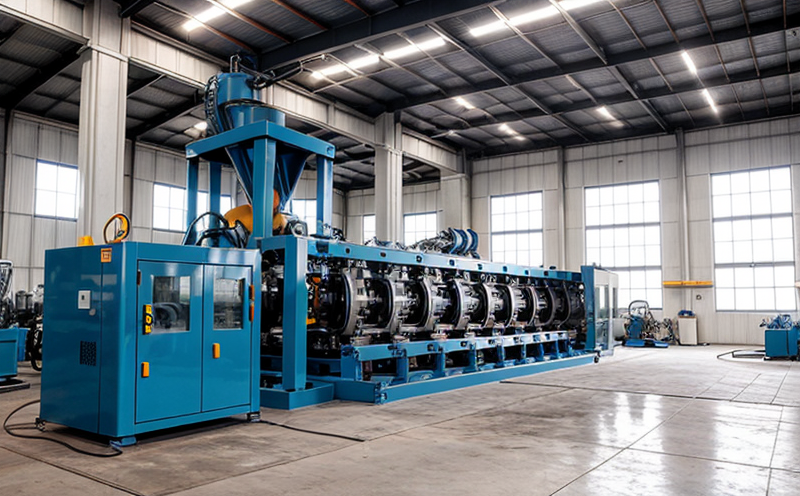ISO 20653 Ingress Protection Performance Testing of Machinery
The International Organization for Standardization (ISO) has established ISO 20653:2018, which provides a framework to assess the ingress protection performance of machinery. This standard is crucial in ensuring that industrial equipment and processing systems are safeguarded against dust, water, and other potential contaminants, thereby enhancing operational reliability and safety.
The primary focus of ISO 20653 is on the protection ratings IPX1 through IPX9K, which categorize the performance levels of machinery to resist ingress from solid particles and liquids. These ratings are essential for industries such as manufacturing, processing, and engineering where robust equipment is vital.
The standard specifies a series of test procedures designed to simulate real-world conditions under which machinery may be exposed to ingress. This ensures that manufacturers can demonstrate compliance with the specified protection levels before deploying their products in demanding environments.
Testing conducted according to ISO 20653 involves subjecting specimens to controlled environmental conditions and specific exposure scenarios. These tests are meticulously designed to replicate actual usage, ensuring that machinery can withstand ingress without compromising performance or safety.
The testing process typically includes the following key steps:
- Identification of ingress sources (dust, water, etc.)
- Determining appropriate test parameters based on expected environmental conditions
- Preparation of specimens in accordance with standard practices
- Conducting exposure tests to specified levels of ingress protection
- Evaluating the performance and integrity of the machinery after exposure
- Generating comprehensive reports detailing test outcomes and compliance status
The results from these tests are critical for quality assurance teams, compliance officers, R&D engineers, and procurement professionals. They ensure that products meet industry standards and can be trusted to perform reliably in harsh environments.
In summary, ISO 20653 is a vital tool for manufacturers seeking to enhance the robustness of their machinery and processing equipment. By adhering to this standard, companies not only improve product quality but also contribute to safer operations across various sectors.
Why Choose This Test
- Enhanced Reliability: Ensures machinery operates reliably in challenging environments, reducing downtime and maintenance costs.
- Safety Assurance: Protects personnel from exposure to hazardous materials or equipment failure due to ingress.
- Compliance with Industry Standards: Demonstrates adherence to international best practices for ingress protection.
- Improved Product Quality: Guarantees that your products meet the highest quality standards, enhancing brand reputation.
- Sustainability Contributions: By ensuring robust equipment, ISO 20653 indirectly supports environmental sustainability by reducing waste and resource consumption.
The benefits of this testing extend beyond immediate product performance. It fosters a culture of continuous improvement within manufacturing and processing industries, ultimately leading to more efficient operations and safer working conditions.
Quality and Reliability Assurance
The quality and reliability of machinery are paramount in industrial manufacturing and processing. ISO 20653 plays a crucial role in this regard by providing stringent guidelines for testing ingress protection performance. This ensures that equipment can withstand the rigors of real-world conditions, thereby enhancing overall product reliability.
Quality assurance teams rely on ISO 20653 to verify that machinery meets specified standards before deployment. This not only safeguards against potential failures but also builds trust with clients and stakeholders. By adhering to this standard, manufacturers can ensure consistent quality across their entire production line.
In terms of reliability, the tests conducted according to ISO 20653 are designed to replicate actual usage scenarios. This ensures that equipment performs optimally under various conditions, reducing the likelihood of unexpected malfunctions. The testing process also helps identify any potential weaknesses in design or manufacturing processes, allowing for timely improvements.
Ultimately, compliance with ISO 20653 is an investment in long-term success. It provides peace of mind to quality managers and compliance officers by ensuring that machinery meets the highest standards of performance and reliability. This contributes to a more efficient and safer industrial environment, where both manufacturers and users can trust the equipment they rely on.
Environmental and Sustainability Contributions
The environmental impact of industrial machinery is significant, with robust protection against ingress being crucial for sustainable operations. ISO 20653 contributes to sustainability by ensuring that machinery remains functional and efficient in challenging environments. This reduces the frequency of replacements and repairs, thereby minimizing waste and resource consumption.
By enhancing the durability and longevity of equipment, ISO 20653 indirectly supports environmental goals. Durable machinery requires less frequent maintenance and repair, leading to lower emissions and reduced energy consumption over its lifecycle. Additionally, the standard helps prevent potential leaks or spills that could harm the environment if ingress protection fails.
Furthermore, adhering to ISO 20653 fosters a commitment to continuous improvement within manufacturing processes. This encourages the development of more efficient and sustainable production methods, ultimately contributing to a greener industrial sector.
In conclusion, ISO 20653 is not only essential for ensuring the reliability and safety of machinery but also plays a significant role in supporting environmental sustainability. By investing in this testing, companies can contribute positively to both their operational efficiency and the broader environmental landscape.





